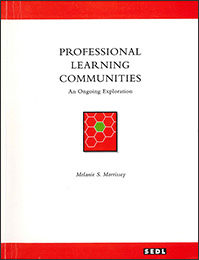A Review of the Five Dimensions
Supportive and Shared Leadership
School change and educational leadership literature clearly recognizes the influence of the role of campus administrator on school improvement (Hord, 1992). This leadership provided by individuals within the school is critical in guiding and supporting successful implementation of new policies and/or practice. Within professional learning communities, the traditional role of omnipotent principal has been replaced by a shared leadership structure. In such a model, administrators, along with teachers, question, investigate, and seek solutions for school improvement. All staff grow professionally and learn to work together to reach shared goals. Campus administrators provide the necessary organizational and structural supports for such collaborative work among staff. Administrators display a willingness to participate in collective dialogue without dominating, and they share the responsibilities of decision making with the staff.
Shared Values and Vision
A fundamental characteristic of the professional learning community’s vision is its unwavering focus on student learning. The shared values and vision among school staff guide decisions about teaching and student learning, and support norms of behavior. In this community, the vision is what Martel (1993) would define as “a total quality focus” (p. 24). The values, as noted earlier, are embedded in the day-to-day actions of the school staff, wherein the learning community engages and develops the commitment and talents of all individuals in a group effort that pushes for learning of high intellectual quality. These values then create the norms of a self-aware, self-critical, and increasingly effective professional organization, utilizing the commitment of its members to seek ongoing renewal and improvement (Sirotnik, 1999; Little, 1997).
Collective Learning and Application of Learning
Originally “collective creativity” (Hord, 1997), the name of this dimension has been changed to reflect more accurately the learning, and the application of learning that occurs. Professional learning communities engage school staff at all levels in processes that collectively seek new knowledge and ways of applying that knowledge to their work. The collegial relationships that result produce creative and appropriate solutions to problems, strengthening the bond between principal and teachers and increasing their commitment to improvement efforts. Such schools move beyond discussions of revising the schedule or establishing new governance procedures to focus on areas that can contribute to significant school improvement— curriculum, instruction, assessment, and the school’s culture. High standards are adopted in all content areas, and professional staff take the responsibility to ensure high levels of achievement for all students. Teachers use a pedagogy that establishes relevance of the curriculum, and students are engaged in learning activities that respond to their cultures and needs as learners (Reyes, Scribner, & Paredes Scribner, 1999). Educators seek the best strategies and instructional practices to engage their students in learning, and they make the necessary adjustments to respond to the students’ diverse learning needs.
Supportive Conditions
Structures that support the vision of a school and learning community are vital to the effectiveness and innovation of teaching at the classroom level. Creating supportive structures, including a collaborative environment, has been described as “the single most important factor” for successful school improvement and “the first order of business” for those seeking to enhance the effectiveness of their school (Eastwood & Louis, 1992, p. 215). Hord (1997) cited two types of supportive structures found within professional learning communities: structural conditions and collegial relationships. The structural conditions include use of time, communication procedures, size of the school, proximity of teachers, and staff development processes. Collegial relationships include positive educator attitudes, widely shared vision or sense of purpose, norms of continuous critical inquiry and improvement, respect, trust, and positive, caring relationships. Within professional learning communities, it is often necessary to find innovative ways to create the necessary time and resources to allocate to whole-staff learning, problem solving, and decision making. Creating supportive conditions is a key to maintaining the growth and development of a community of professional learners.
Shared Personal Practice
Elmore (2000) states that “schools and school systems that are improving directly and explicitly confront the issue of isolation” by creating multiple avenues of interaction among educators and promoting inquiry-oriented practices while working toward high standards of student performance (p. 32). Teacher interaction within a formalized structure for collegial coaching provides the means for confronting the issue of isolation in professional learning communities. Through such interaction, teachers continue to build a culture of mutual respect and trustworthiness for both individual and school improvement, and they also exhibit increased commitment to their work. Shared personal practice is limited, even in highly functioning learning communities, and tends to be the last of the dimensions to develop. Darling-Hammond (1998) cites research reporting that teachers who spend more time collectively studying teaching practices are more effective overall at developing higher-order thinking skills and meeting the needs of diverse learners. Sharing personal practice requires a complete paradigm shift from traditional roles in education. It is, however, the clearest link to the classroom.
A professional learning community produces high levels of achievement for all students within an environment of continuous inquiry and improvement if it is focused on student results. It values and respects each of its members and insists that all students achieve to high standards. One factor organizes all contexts within a professional learning community, and that is the shared purpose of improving student learning outcomes. All members of such a community are invested in the learning and changing necessary to address the needs of all students and help them to achieve high standards of learning.
Next Page: Recent Literature

